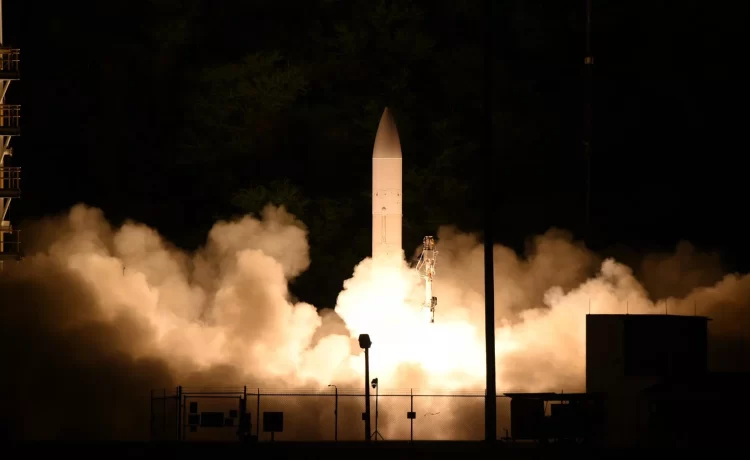Insider Brief
- At a recent workshop hosted by the Hudson Institute and Space Foundation, U.S. lawmakers, military officials, and defense experts discussed the importance of hypersonic missile technology, emphasizing its role in maintaining national security and deterring adversaries.
- The participants highlighted the need for the U.S. to both develop hypersonic offensive capabilities and strengthen defenses against these advanced weapons, with international collaboration playing a crucial role.
- The workshop also stressed the importance of increasing the pace of hypersonic testing and leveraging public-private partnerships to advance development.
The United States military is increasingly focused on developing hypersonic missile capabilities and bolstering its defenses against these advanced weapons, which can travel at speeds exceeding five times the speed of sound (Mach 5) and evade traditional missile defense systems.
In a recent workshop hosted by the Hudson Institute and the Space Foundation, key U.S. lawmakers, military officials, and defense experts convened to discuss the future of hypersonic technology and the challenges it presents for national security. The event, held in Washington, D.C., included Congressmen Doug Lamborn (R-CO), Vince Fong (R-CA), and Donald Norcross (D-NJ), as well as Admiral James A. Winnefeld Jr. and former Department of Defense officials Mike White and John Plumb.
The participants emphasized the need for the U.S. to accelerate its development of hypersonic weapons and defense systems, warning that America risks falling behind adversaries like China and Russia in this emerging technology.
The workshop experts provided insight into the current state of U.S. hypersonic programs and the steps needed to maintain a strategic edge.
Hypersonic Weapons Are Essential for Strategic Deterrence
Congressman Doug Lamborn, who chairs the House Armed Services Subcommittee on Strategic Forces, opened the discussion by stressing the importance of hypersonic weapons for U.S. military capabilities.
“Our military commanders tell us that they will need to potentially strike a specific set of highly important targets, that are at a great distance, early in a conflict, with a high degree of confidence of success,” Lamborn said.
He said that current U.S. missile systems, including slow cruise missiles and ballistic missiles with predictable flight paths, are inadequate when facing adversaries equipped with sophisticated missile defense systems.
Hypersonic missiles, which travel at extreme speeds and can maneuver unpredictably, offer a solution to this problem. Their ability to evade defenses and strike distant targets with precision makes them a vital tool for deterrence and, if necessary, early engagement in a conflict. Lamborn emphasized that developing these capabilities is not just a technological race but a national security imperative.
Defending Against Hypersonic Missiles Is Critical
While much of the discussion focused on offensive hypersonic capabilities, defense against these weapons is equally important.
Admiral James A. Winnefeld Jr., a former vice chairman of the Joint Chiefs of Staff, reviewed the challenges posed by hypersonic weapons, drawing from his experience as an F-14 pilot. He recalled a training exercise where he attempted to track and engage an SR-71 Blackbird, an aircraft capable of flying at speeds over Mach 3.
And the example I would give you is as a young mid-grade F-14 pilot, I lucked into this situation where I was able to attempt to track and simulate an engagement on an SR-71. . . . It was an order of magnitude more difficult than anything I’d ever done in terms of intercepting something or trying to intercept something. And that was only going Mach 3.”
A hypersonic missile travels even faster and can maneuver mid-flight.
John Plumb, a former Assistant Secretary of Defense for Space Policy, added that the developing the Glide Phase Interceptor (GPI) could lead to a defense system designed to intercept hypersonic missiles during the glide phase of their trajectory—when the missile is traveling at hypersonic speeds but before it begins terminal maneuvers.
Plumb said that forcing a hypersonic missile to maneuver increases its drag and thermal load, which could reduce its ability to evade interception in the final phase of flight. The U.S. must invest in both offensive and defensive hypersonic capabilities to ensure a robust strategic posture, he argued.
Congressman Donald Norcross said that a layered, mutual defense would be necessary – and U.S. allies would be critical.
“We’re talking about a layered defense and what will take place in the defense of Guam,” said Norcross. “So having partner countries, Japan, Philippines, Australia, Japan, South Korea—incredibly important when we’re trying to forward deploy many of the things that we would need if there was conflict to break out. But first and foremost is to protect Americans and American assets. And it starts with Guam.”
Expanding Hypersonic Testing Is Necessary
One of the major challenges facing the U.S. hypersonics program is the slow pace of testing. Congressman Lamborn brought up this issue at the workshop, citing testimony from George Rumford, director of the Pentagon’s Test Resource Management Center (TRMC), who told Congress that the U.S. should be conducting hypersonic flight tests on a weekly basis. Currently, such tests occur quarterly, at best.
“We need to start flying more often and get comfortable with incurring risks that are associated with a higher test cadence,” Lamborn said.
Testing is essential for refining hypersonic technologies and ensuring they are ready for operational use. Lamborn advocated for full funding of the Mach-TB program, a Pentagon initiative aimed at increasing the frequency of hypersonic flight tests. He said that if the Department of Defense (DoD) fails to prioritize the program, Congress should mandate it in next year’s National Defense Authorization Act (NDAA) and ensure the DoD allocates the necessary resources.
International Collaboration Can Accelerate Development
Another key point raised during the workshop was the importance of international cooperation in hypersonic technology development. According to Mike White, former Principal Director for Hypersonics in the Office of the Secretary of Defense, the U.S. is not in an arms race with China or Russia but is engaged in a “capability race.” China’s anti-access/area denial (A2/AD) strategy, which seeks to block U.S. military access to key regions, poses a significant challenge to traditional American military assets, White said. Hypersonic weapons could play a critical role in overcoming these defenses.
White emphasized the need for the U.S. to work closely with its allies to accelerate the maturation of hypersonic capabilities. By pooling resources and expertise, allied nations can develop and field hypersonic weapons more quickly and in greater numbers.
White said; “… We are in a capability race to field [a] capability that defeats the defenses of the adversary that hold out our traditional systems. And that’s the criticality of what we need and why we need it from that perspective. And bringing our allies on board to accelerate the maturation of the capability and then work with us to accelerate the fielding in numbers is going to be critical.”
Public-Private Partnerships and Regulatory Reform Are Key
The final major takeaway from the workshop was the need to reduce regulatory barriers and empower the private sector to play a larger role in hypersonic development. Congressman Vince Fong highlighted the success of commercial space companies like SpaceX in partnering with the DoD to launch military satellites and other sensitive payloads into orbit. He argued that similar public-private partnerships are necessary to scale up hypersonic testing and production.
According to Fong, there is a need for increased launch cadence and testing, which will require a more dynamic partnership between the government and private industry. Reducing regulatory obstacles and streamlining the acquisition process will be critical to maintaining the U.S.’s competitive edge in hypersonic technologies.
“When you talk about the commercial space, I mean, we have to learn some hard lessons in terms of how we apply it to hypersonics,” said Fond. “Now that SpaceX is one of the partners that helps us launch DoD and other sensitive missions into space, space is going to be the next frontier for us. And so having the commercial-DoD public-private partnership—that’s critical for us, especially with the need to increase our cadence and launches.”
Image credit: The Hudson Institute
















